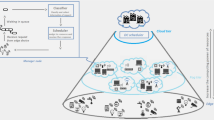Abstract
Optical burst switching (OBS) networks have been receiving much attention as a promising approach to build the next generation optical Internet. In the bufferless DWDM switching technology, burst loss that should be minimized is the key design parameter. One of the critical design issues in OBS network is how to plan the optimal routing path in order to minimize burst dropping due to network resource contention. This study proposes the burst frequent-pattern tree (BFP-Tree) approach to pre-determine a suitable routing path in the OBS network. The BFP-Tree approach essentially is a learning-based mechanism that is able to determine a suitable transmission path from the historical network transaction data. The experiment results show that the successful rates of routing paths obtained by the BFP-Tree approach are able to converge to those of the optimal results.
Similar content being viewed by others
References
Kaminow I.P. et al.: A wideband all-optical WDM network. IEEE J. Sel. Areas Commun. 14(5), 780–799 (1996) doi:10.1109/49.510903
Qiao C., Yoo M.: Optical burst switching (OBS)-a new paradigm for an optical internet. J. High Speed Netw 8(1), 69–84 (1999)
Li J., Qiao C., Chen Y.: Recent progress in the scheduling algorithms in optical-burst-switching networks. J. Opt. Networking 3(4), 229–241 (2004) doi:10.1364/JON.3.000229
Karasan E., Ayanoglu E.: Effects of wavelength routing and selection algorithms on wavelength conversion gain in WDM optical networks. IEEE/ACM Trans. Networking 6(2), 186–196 (2002)
Teng J., Rouskas G.N.: Wavelength selection in OBS networks using traffic engineering and priority-based concepts. IEEE J. Sel. Areas Commun. 23(8), 1658–1669 (2005) doi:10.1109/JSAC.2005.851794
Bregni S., Guerra G., Pattavina A.: Optical switching IP traffic using input buffered architectures. Opt. Netw. Mag. 3(6), 20–29 (2002)
Hunter D.K., Chia M.C., Andonovic I.: Buffering in optical packet switches, IEEE/OSA. J. Lightwave Technol. 16(12), 2081–2094 (1998) doi:10.1109/50.736577
Anpeng H., Linzhen X.: A novel segmentation and feedback model for resolving contention in optical burst switching. Photonic Netw. Commun. 6(1), 61–67 (2003) doi:10.1023/A:1023638825222
Lee S., Kim H., Song J., Griffith D.: A study on deflection routing in optical burst-switched networks. Photonic Netw. Commun. 6(1), 51–59 (2003) doi:10.1023/A:1023686708384
Wang X., Morikawa H., Aoyama T.: Priority-based wavelength assignment algorithm for burst switched WDM optical networks. IEICE Trans. Commun. e86-b(5), 1508–1514 (2003)
Ishii D., Yamanaka N., Sasase I.: Self-learning route selection scheme using multi-path searching packets in an OBS network. J. Opt. Networking 4(7), 432–445 (2005) doi:10.1364/JON.4.000432
Yang L., Rouskas G.N.: Adaptive path selection in OBS networks, IEEE/OSA. J. Lightwave Technol. 24(8), 3002–3011 (2006) doi:10.1109/JLT.2006.878087
Agrawal, R., Imielinski, T., Swami, A.: Mining association rules between sets of items in large databases. Proceedings of the ACM-SIGMOD International Conference, pp. 207–216. Washington, D. C., USA, May 1993
Borgelt, C., Kruse, R.: Induction of association rules: apriori implementation. 15th Conference on Computational Statistics, pp. 395–400, (Compstat 2002, Berlin, Germany). Physica Verlag, Heidelberg, Germany (2002)
Orlando, S., Palmerini, P., Perego, R.: Enhancing the apriori algorithm for frequent set counting. Proceedings of the 3rd International Conference on Data Warehousing and Knowledge Discovery, pp. 71–82. Munich, Germany, September 5–7, (2001)
Chen G., Wei Q.: Fuzzy association rules and the extended mining algorithms. Inf. Sci. 147(1–4), 201–228 (2002)
Han J., Pei J., Yin Y., Mao R.: Mining frequent patterns without candidate generation: a frequent-pattern tree approach. Data Min. Knowl. Discov. 8(1), 53–87 (2004) doi:10.1023/B:DAMI.0000005258.31418.83
Hwang I.S., Chiu C.C., Su R.R., Shyu Z.D.: Burst routing planning for optical networks using the association rule approach. Int. J. Comput. Sci. Netw. Secur. (IJCSNS) 6(10), 173–178 (2006)
Wu C.: Applying frequent itemset mining to identify a small itemset that satisfies a large percentage of orders in a warehouse. Comput. Oper. Res. 33(11), 3161–3170 (2006) doi:10.1016/j.cor.2005.01.026
Qiao C.: Labeled optical burst switching for IP-over-WDM integration. IEEE Commun. Mag. 38(9), 104–114 (2000) doi:10.1109/35.868149
Maunder, A.S., Hjálmtýsson, G., VanderMerwe, K., Ramakrishnan K.K.: Evaluating the performance of UNITE’s hop-by-hop routing vs. source routing, ATM Forum/98–0784, October (1998)
Author information
Authors and Affiliations
Corresponding author
Rights and permissions
About this article
Cite this article
Hwang, IS., Chiu, C. & Shyu, ZD. A frequent-pattern approach for optical networks routing planning. Photon Netw Commun 17, 218–225 (2009). https://doi.org/10.1007/s11107-008-0156-8
Received:
Accepted:
Published:
Issue Date:
DOI: https://doi.org/10.1007/s11107-008-0156-8




